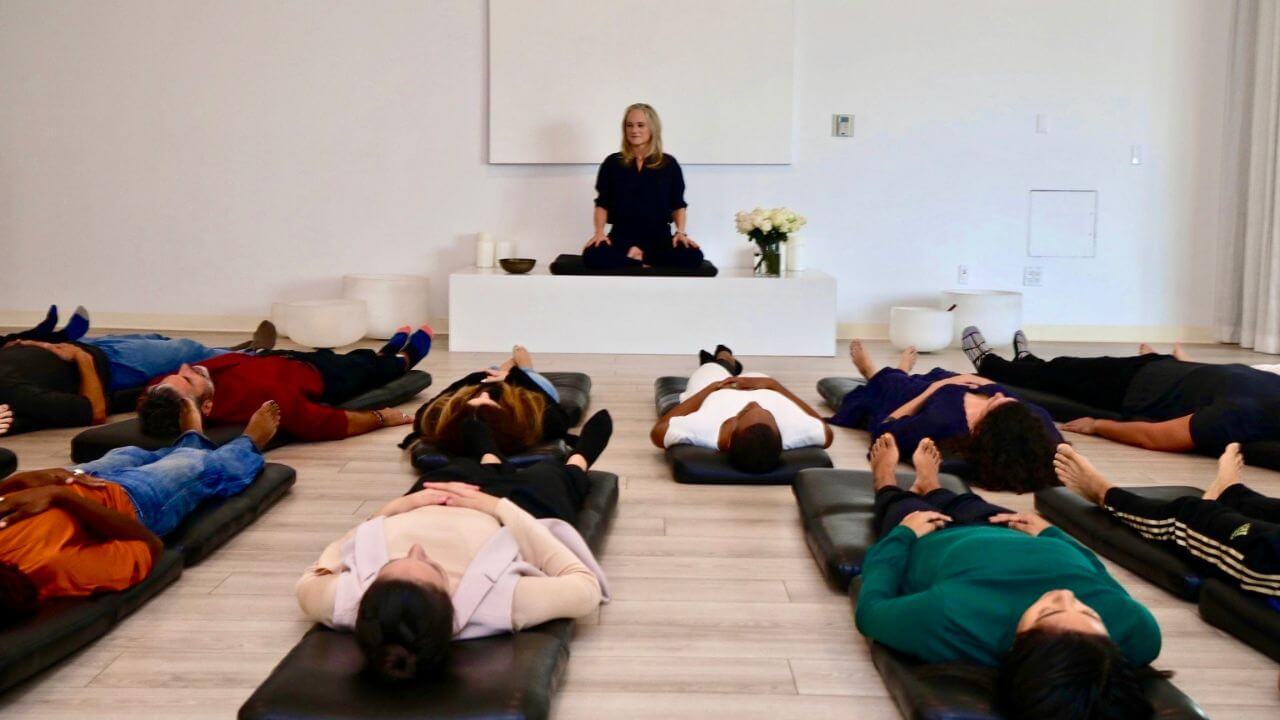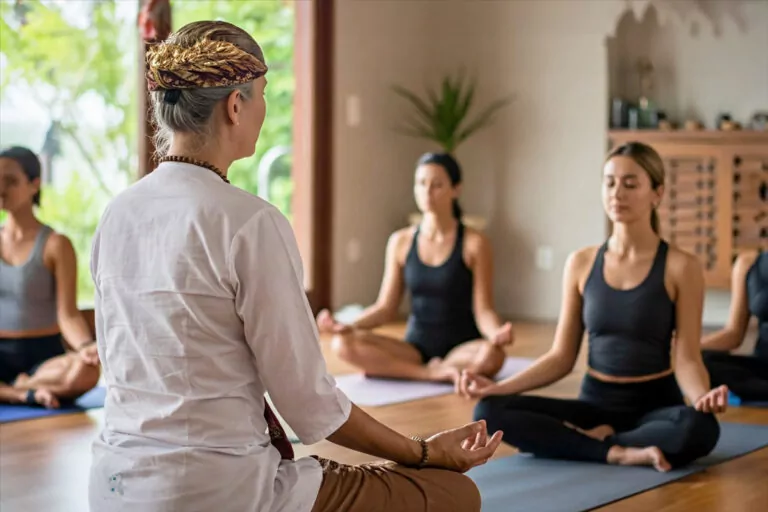Meditation has always been more than just a personal practice. Across centuries and cultures, the presence of teachers, mentors, and guided programs has shaped the way seekers approach inner stillness. From ancient yogic gurus to contemporary meditation coaches, guidance has often made the difference between a short-lived attempt and a lifelong practice. In today’s fast-paced world, teachers & guided programs not only preserve the wisdom of traditional methods but also adapt meditation to modern needs. This article explores the role and value of teachers & guided programs in meditation, and offers a closer look at some notable figures and initiatives.
Why Teachers & Guided Programs Are Important in Meditation?
Meditation may seem simple as sitting quietly and focusing inward, but in practice, it often presents challenges. Beginners may struggle with racing thoughts, physical discomfort, or uncertainty about whether they are “doing it right.” Even experienced practitioners sometimes face plateaus or doubt. This is where teachers & guided programs play an essential role.
Providing Structure and Clarity:
One of the biggest obstacles in meditation is a lack of direction. A teacher or guided program gives clear instructions—whether it’s how to sit, where to place attention, or how to handle distractions. Instead of guessing, practitioners can confidently follow a proven method.
Overcoming Common Challenges:
Teachers & guided programs help normalize struggles like restlessness, boredom, or frustration. For instance, when thoughts keep interrupting, a teacher may explain that this is natural and guide students toward gentle redirection. Guided meditations also provide reassuring cues at the right time, helping practitioners stay on track.
Maintaining Motivation and Consistency:
Consistency is key to meditation, yet many people lose interest after a few days. Programs create accountability by offering structured schedules, progress tracking, or community support. Teachers & guided programs, on the other hand, encourage and inspire by sharing personal experiences and wisdom.
Tailoring the Practice to Individual Needs:
Everyone comes to meditation with different goals—stress relief, better focus, emotional healing, or spiritual awakening. A teacher can adapt techniques to suit the individual, while guided programs offer specialized meditations for sleep, anxiety, productivity, or self-discovery.
Deepening Understanding and Insight:
Beyond relaxation, meditation can lead to profound self-awareness and transformation. Teachers introduce philosophies, self-inquiry methods, and advanced practices that deepen insight. Guided programs may not go as deep philosophically, but they often weave in psychology and neuroscience to enhance understanding.
Building a Sense of Community:
Practicing alone can feel isolating, especially when challenges arise. Teachers often create sanghas (spiritual communities), and guided programs may connect users through online forums. This sense of belonging makes the practice more sustainable and enjoyable.
Accelerating Progress:
Without guidance, practitioners may spend years experimenting with techniques that don’t suit them. Teachers & guided programs prevent wasted effort by providing methods that are time-tested and results-oriented. This shortens the learning curve and helps meditators experience benefits sooner.
Best Teachers & Guided Programs in Meditation:
Meditation is one of the most powerful tools for cultivating inner peace, clarity, and resilience. Yet for many people, starting a meditation practice can feel overwhelming. Questions like “Which method is right for me?” or “How do I stay consistent?” often arise. This is where teachers & guided programs become invaluable. The right guidance can transform meditation from a confusing exercise into a life-changing habit.
In the following sections, we’ll explore some of the best teachers & guided programs in meditation, highlighting their unique methods, philosophies, and benefits, so you can find the approach that resonates most with your journey.
Abraham Hicks Meditation:
Abraham Hicks represents a unique fusion of meditation with the Law of Attraction philosophy. Through Esther Hicks, who channels the collective consciousness called “Abraham,” these teachings emphasize aligning with positive emotions and universal energy.
- Approach: Meditations often use calming background music and focus on breathing or repeating uplifting affirmations.
- Core Idea: By calming the mind, individuals align with their “inner being,” making it easier to manifest desires and live joyfully.
- Impact: Many followers report greater emotional balance, a sense of empowerment, and more synchronicity in daily life.
Unlike traditional meditation that emphasizes detachment, Abraham Hicks meditation encourages active participation in co-creating one’s reality. It attracts people who want spirituality blended with practical manifestation tools.
Emily Fletcher – Ziva Meditation:
Emily Fletcher, a former Broadway performer, discovered meditation as a solution to stress and burnout. She developed Ziva Meditation, which she has since taught to thousands worldwide, including top professionals and organizations.
The Ziva Technique:
Emily’s system combines three pillars:
- Mindfulness – Managing stress in the present moment.
- Meditation – A technique based on ancient practices to access deep rest.
- Manifesting – Using visualization to shape future goals.
Why It Works?
- Practical: Designed for busy people who don’t have hours to meditate.
- Evidence-based: Supported by neuroscience and stress reduction research.
- Results-oriented: Helps with better sleep, stronger immunity, and improved creativity.
Emily Fletcher bridges spirituality and science, making meditation approachable for skeptics and corporate professionals alike. Her work shows that meditation is not about escaping life but enhancing performance in it.
Mooji Meditation:
Mooji, born Anthony Paul Moo-Young in Jamaica, is a disciple of Papaji, a student of the renowned sage Ramana Maharshi. His teachings are rooted in Advaita Vedanta (non-duality).
Core Elements of Mooji’s Approach:
- Self-Inquiry: Instead of focusing on techniques, Mooji encourages seekers to ask, “Who am I?”
- Silence: Many of his guided meditations involve resting in awareness without effort.
- Awakening: The goal is liberation from the ego and realization of the eternal Self.
Mooji’s gatherings, known as satsangs, are filled with dialogue, guided silence, and profound simplicity. His meditations appeal to those who seek not just calmness but a fundamental shift in consciousness. Unlike structured methods, Mooji emphasizes surrender and being.
UCLA Guided Meditation:
The UCLA Mindful Awareness Research Center (MARC) stands at the intersection of science and spirituality. With a mission to make mindfulness accessible and evidence-based, they provide free audio and video guided meditations online.
Features of UCLA Meditations:
- Mindfulness Focus: Practices include breathing awareness, body scans, and compassion training.
- Length Options: Sessions range from a few minutes to longer practices.
- Accessibility: Available in multiple languages and free of charge.
Why People Choose UCLA Programs:
- Rooted in clinical research on stress reduction and mental health.
- Trusted by healthcare professionals, educators, and psychologists.
- Perfect for beginners who prefer secular, science-backed practices.
UCLA has helped normalize meditation in mainstream wellness, making it a tool for stress management rather than just a spiritual pursuit.
Synctuition Meditation:
Synctuition meditation is one of the most innovative meditation platforms today. It uses 3D soundscapes, binaural beats, and guided narration to create immersive meditation journeys.
How It Works?
- Binaural Beats: Influence brainwaves to encourage relaxation or focus.
- 3D Sound Technology: Creates a feeling of being inside a virtual sound environment.
- Personalized Journeys: Sessions adapt to user preferences and progress.
Synctuition is ideal for people who struggle with traditional meditation but respond well to audio stimulation. It blends neuroscience with spiritual exploration, offering a futuristic way to meditate.
Comparing Different Teachers & Guided Programs:
| Teacher/Program | Core Focus | Ideal For | Unique Element |
|---|---|---|---|
| Abraham Hicks | Alignment & Law of Attraction | Spiritual seekers, manifestation practice | Channeling & affirmations |
| Emily Fletcher (Ziva) | Mindfulness + Meditation + Manifesting | Busy professionals, skeptics | Practical, science-backed |
| Mooji | Self-inquiry & non-duality | Spiritual aspirants seeking awakening | Satsang dialogues & silence |
| UCLA Guided Meditation | Mindfulness & stress reduction | Students, healthcare workers, general public | Free, research-based |
| Synctuition | Sound-based immersive meditation | Tech lovers, beginners, creatives | 3D sound & binaural beats |
This diversity illustrates that meditation is not a “one-size-fits-all” practice. Each program caters to different goals, from stress relief to spiritual awakening.
Benefits of Learning from Teachers & Guided Programs:
Meditation is a powerful tool for inner peace, clarity, and healing, but the journey can often feel overwhelming when practiced alone. This is where teachers & guided programs play a vital role. With their wisdom, structure, and support, they make meditation easier to understand and more effective. Learning through guidance offers unique benefits that help practitioners grow steadily and deeply.
Personalized Guidance:
A teacher understands your individual needs, background, and challenges, offering meditation practices tailored just for you. This personal attention ensures you practice correctly and safely while progressing steadily. Unlike generalized methods, guided programs provide structure and clarity, making it easier to integrate meditation into your lifestyle without feeling lost or overwhelmed.
Proper Technique:
Meditation involves correct posture, breathwork, and mental focus. Without guidance, beginners may develop habits that hinder progress. Teachers demonstrate the right technique, while guided programs reinforce it through structured practice. This prevents mistakes, reduces frustration, and allows you to experience meditation’s true depth and benefits more effectively than learning on your own.
Accountability & Discipline:
Consistency is the key to meditation’s success, but self-practice often lacks discipline. Teachers & guided programs create accountability through regular schedules and encouragement. This structured support helps you maintain steady practice, even during busy or challenging times. Over time, this discipline strengthens your focus, improves results, and makes meditation a natural part of daily life.
Faster Progress:
Self-learning through trial and error can take years, while teachers shorten the journey by sharing wisdom gained from long experience. Teachers & guided programs offer tested methods and step-by-step instructions, ensuring smoother progress. With expert support, you quickly overcome obstacles, deepen your practice, and experience meditation’s mental and emotional benefits much faster than practicing alone.
Motivation & Encouragement:
Meditation can sometimes feel challenging or unproductive, causing people to give up. Teachers encourage, reminding you of the value of persistence, while guided programs keep you inspired with fresh practices and teachings. Having external support boosts confidence, helping you stay motivated even during slow phases. This positive reinforcement keeps your meditation journey alive and rewarding.
Emotional & Spiritual Support:
Meditation can bring hidden emotions or deep inner experiences to the surface. Teachers & guided programs offer safe support to navigate these phases with understanding and wisdom. They provide reassurance during emotional releases and spiritual growth, making the process smoother. With such guidance, you feel less isolated, more confident, and better equipped to handle inner transformations.
Access to Tradition & Wisdom:
Many teachers come from ancient meditation traditions, while guided programs combine traditional knowledge with modern psychology. Learning from them connects you to practices refined over centuries and supported by science. This gives authenticity and depth to your meditation, ensuring you benefit from time-tested wisdom rather than relying on random, unverified methods that may lack real effectiveness.
Variety of Techniques:
Meditation is not one-size-fits-all. Teachers & guided programs introduce you to multiple techniques like mindfulness, mantra, visualization, or loving-kindness meditation. This variety allows you to experiment and discover what resonates most with your personality and needs. Exploring different practices keeps your journey fresh, prevents monotony, and ensures a well-rounded growth in both mental and emotional well-being.
Healing & Therapeutic Benefits:
Many guided programs include meditations for stress, anxiety, better sleep, or emotional healing. Teachers & guided programs can recommend specific techniques that target personal struggles. This makes meditation not just a spiritual practice but also a therapeutic tool. With expert guidance, you can apply meditation to daily challenges, enhancing health, balance, and emotional resilience in ways self-learning may not achieve.
Community & Connection:
Meditating with teachers or in guided programs often includes group practice, creating a sense of community and belonging. Sharing experiences with others offers encouragement and strengthens commitment. Being part of a group amplifies energy, making meditation deeper and more enjoyable. This supportive environment also helps you stay consistent, motivated, and connected on your inner journey.
Conclusion:
Teachers & guided programs in meditation are bridges between seekers and the infinite potential within. They provide structure for beginners, depth for serious practitioners, and accessibility for modern lifestyles.
In the end, the right teacher or program is the one that resonates with your heart and fits your lifestyle. Whether you are seeking calmness, spiritual awakening, or enhanced creativity, guided meditation ensures that the journey inward is never walked alone.
FAQ:
Q. Why do I need a teacher or guided program for meditation?
A. While meditation can be practiced independently, teachers & guided programs provide structure, clarity, and motivation. They help beginners avoid confusion, deepen practice, and stay consistent, especially when challenges like distraction or doubt arise.
Q. Can guided meditations replace a live teacher?
A. Guided meditations are excellent tools for accessibility and consistency, but they may lack the personal touch of a live teacher. A teacher can tailor practices to your needs, while guided programs offer flexibility and variety. Many practitioners combine both for the best results.
Q. Are Abraham Hicks, Emily Fletcher, and Mooji’s teachings suitable for beginners?
A. Yes, but with different focuses. Abraham Hicks is best for those interested in manifestation, Emily Fletcher suits busy professionals looking for practical benefits, and Mooji is more suitable for seekers of spiritual awakening. Beginners should choose based on their goals.
Q. How is UCLA Guided Meditation different from spiritual approaches?
A. UCLA’s meditations are scientific and secular, focusing on mindfulness for stress reduction and emotional balance. Unlike spiritual teachings, they don’t involve self-inquiry, manifestation, or philosophical exploration. This makes them accessible to anyone, regardless of belief system.
Q. What makes Synctuition unique compared to traditional meditation?
A. Synctuition uses 3D sound technology and binaural beats to create immersive experiences. Instead of silent sitting, users are guided through sound journeys that promote relaxation, creativity, and sleep. It’s especially helpful for beginners who find traditional methods difficult.
Q. How do I choose the right meditation program for me?
A. Start by clarifying your intention. If you want stress relief, mindfulness programs like UCLA are ideal. For manifestation, Abraham Hicks is suitable. If you seek deep spiritual awakening, Mooji’s teachings resonate best. Tech lovers may enjoy Synctuition, while busy professionals can try Emily Fletcher’s Ziva method.
Q. Do guided programs guarantee results?
A. No program or teacher can guarantee results. Meditation is a personal journey that depends on consistency, openness, and patience. Teachers & guided programs act as supportive tools, but transformation comes from regular practice and self-commitment.







